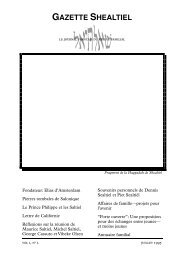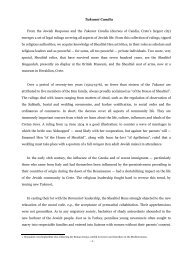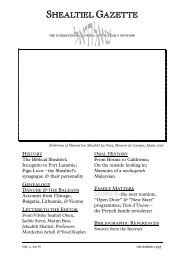a thesis by Flora Jane Satt - Shealtiel
a thesis by Flora Jane Satt - Shealtiel
a thesis by Flora Jane Satt - Shealtiel
Create successful ePaper yourself
Turn your PDF publications into a flip-book with our unique Google optimized e-Paper software.
<strong>Flora</strong> <strong>Jane</strong> <strong>Satt</strong>—annotated <strong>by</strong> Miles SaltielPart VI, ConclusionsDespite its failure, its remoteness, its impermanence and its longsubmergence in undocumented oblivion, the Cotopaxi Colony didhave significance in the shaping of American-Jewish agriculturalhistory. In the immigrant Jew’s attempt to return to the soil, to returnto his ancient national character of the agrarian, the colonyexperiment played a definite and important role. This colony atCotopaxi happened to be the first of more than sixteen similarJewish colonies, located in Louisiana, Arkansas, the Dakotas, Kansas,Nebraska, Oregon and Michigan. Although individually Jewshad long been active and successful in American agriculture, thecolony plan, as demonstrated <strong>by</strong> successful groups during the1870’s, such as the Union and Chicago colonies in Colorado,seemed better suited for the conquest of the arid high plains andthe distant Mountain and Pacific Coast regions, especially fornewly-arrived Jews. Other national and religious groups had chosenthe collective method as the best way to achieve security and acomfortable social milieu in unfriendly or desolate areas.Analyses of the histories of these other Jewish Colonies, many ofwhich experienced even worse hardships and exploitation schemesthan the one at Cotopaxi, show the same underlying causes forfailure. Most of them were conceived in haste, under great pressure,emotional and political, without adequate consideration ofthose factors upon which successful colonization or even profitableprivate farming, depend. Geographical location, with relationshipto markets, national and local economy, transportation, the characterof the land, type of ownership, lease or title, the capitalneeds, availability of equipment and seed, the existence of anyspecial problems such as the necessity for irrigation, drainage, erosioncontrol, the economic and social condition of the neighboringfarmers in comparison with the prospective colonists, the natureof work involved, the personality and integrity of sponsorship andleadership, and last, but not least, the homogeneity of purpose and31








